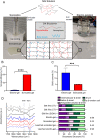Impact of silk hydrogel secondary structure on hydrogel formation, silk leaching and in vitro response
- PMID: 35260610
- PMCID: PMC8904773
- DOI: 10.1038/s41598-022-07437-4
Impact of silk hydrogel secondary structure on hydrogel formation, silk leaching and in vitro response
Abstract
Silk can be processed into a broad spectrum of material formats and is explored for a wide range of medical applications, including hydrogels for wound care. The current paradigm is that solution-stable silk fibroin in the hydrogels is responsible for their therapeutic response in wound healing. Here, we generated physically cross-linked silk fibroin hydrogels with tuned secondary structure and examined their ability to influence their biological response by leaching silk fibroin. Significantly more silk fibroin leached from hydrogels with an amorphous silk fibroin structure than with a beta sheet-rich silk fibroin structure, although all hydrogels leached silk fibroin. The leached silk was biologically active, as it induced vitro chemokinesis and faster scratch assay wound healing by activating receptor tyrosine kinases. Overall, these effects are desirable for wound management and show the promise of silk fibroin and hydrogel leaching in the wider healthcare setting.
© 2022. The Author(s).
Conflict of interest statement
The authors declare no competing interests.
Figures



References
-
- Greaves NS, Benatar B, Baguneid M, Bayat A. Single-stage application of a novel decellularized dermis for treatment-resistant lower limb ulcers: Positive outcomes assessed by SIAscopy, laser perfusion, and 3D imaging, with sequential timed histological analysis. Wound Repair Regen. 2013;21:813–822. doi: 10.1111/wrr.12113. - DOI - PubMed
Publication types
MeSH terms
Substances
LinkOut - more resources
Full Text Sources
Other Literature Sources

